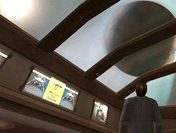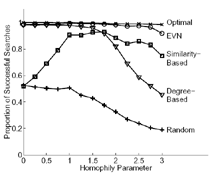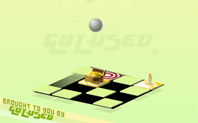
Hey all — I’ve had several requests over the last few months to provide full-text RSS feeds! I was too lazy until now to do it, but I think I’ve got ‘em set up.
I say think because I’m not sure I’ve set them up correctly for full text. Let me know in the comments below if I’ve done it right!
We now return you to your regular programming.

I’ve written in the past about the “Uncanny Valley” — the phenomenon that as computer graphics become more and more lifelike, the characters they create look more and more ghoulish. The problem, as I wrote in Slate last year, is that we humans are good at anthropomorphizing very crudely-drawn figures, such as Charlie Brown or Calvin and Hobbes. We fill in the details and find them cute and cuddly. But when a graphical representation of a human becomes so close to reality that it’s 99% perfect, our attention shifts — and we suddenly start noticing the 1% that isn’t right. Usually it’s something wrong with the face: The eyes look dead, the skin doesn’t move correctly. The characters start looking, quite inadvertantly, like zombies. I sometimes wonder whether computer games and animators will ever get past this hump; maybe we’ll always find nearly-realistic human animations freaky-looking.
Ah, but maybe there’s a much, much weirder solution waiting in the wings. What if people — real people, in real life — stop looking fully realistic, and start looking almost-not-quite-real?
This is the incredibly interesting idea put forward in a new essay by Robert Fabricant, a creative director at Frog Design. He points out that the rise of plastic surgery is producing a new wave of people who look just as surreal as our computerized avatars. As he writes:
It is ironic that, as we perfect the algorithms for simulating facial expressions in 3D software, we are embracing cosmetic treatments that reduce the fidelity and individuality of our own facial expressions. Over the last few years there has been a 20-50% annual increase in the number of minimally-invasive cosmetic procedures (depending on the procedure). And there has been an utter acceptance and celebration of cosmetic surgery in the media with shows like Fox’s “The Swan” and ABC’s “Extreme Makeover.” It is easy to imagine a point in the future when these two trends converge and we all look like Angelina Jolie — errr, Lara Croft.
That chart above is from Fabricant’s essay, and wittily illustrates the merging of these two trends. He also points out lots of other weird mergings of digital and real-life aesthetics, including the Xbox game Yourself!Fitness, in which a hot virtual chick enjoins you to develop a body as perfectly sculpted as hers.
(Thanks to Michele Tepper for this one!)

Dig this: A space station inside the online, multiplayer game Project Entropia has just been sold for $100,000. The buyer was Jon Jacobs, a very popular in-game figured known as “Neverdie”. Why spend so much on a piece of virtual property? Because it’s just like owning the Mall of America — it’s a place to conduct business and make real-world cash. Indeed, Project Entropia currently has 236,000 registered accounts, and the game allows you to use Earth money to buy in-game currency, which makes it spectacular place for any entrepreneur to set up business, really.
From Project Entropia’s web site, here’s a description of the space station:
Designed as a Pleasure Paradise, the Resort built on an Asteroid is a monumental project aimed at being a primary destination for Entertainment in the known Virtual Universe.
Boasting a 1000 Apartment complex, Commercial Space Ship Docking, Themed Shopping Mall, Mega Stadium for championship sporting events, Nightclub with multiple Dance floors, Live Amphitheater, lounges, and 10 Hunting Biodomes with individual land management facilities which will enable the creative owner to create Rare, Unique and Exotic creatures. Mining and PVP areas are available. In addition the Resort will feature Owner Operated PA System for Streaming Music and Video to biodomes and screens/billboards strategically placed throughout the space resort and for a fee even a Planet side Video Billboard Network located in all major towns and cities can be accessed for marketing.
No teleporter available at the resort, travel to and from the resort only by Space ships.
Gotta love that last detail. As readers of this blog know, I’ve long been intrigued by in-game economics, and wrote a huge piece about this last year for The Walrus — it’s online here if you want to read it.
(By the way, that picture above is not of the space station — I couldn’t find any images of it online. That’s just a random in-game shot.)
(Thanks to Morgan for this one!)

In the last week, the Blue Angels — a team of Navy performance pilots — have been zooming across the skies over San Francisco. The blogger Nivi decided he was going to pull out his digital camera and take some pictures of them for his friend Christa Favot.
But then he realized … hmmm, there were probably already oodles of such pictures already posted to Flickr. He checked and, sure enough, users had put up dozens of superb, magazine-quality shots.
This led Nivi to posit a funny new meme: LazyPhoto. If you’ve ever heard of the LazyWeb concept, it is, as Wikipedia describes it:
The idea if you wait long enough, someone will implement that wacky idea you had… (or already has!) Alternately, that if your blog or other publishing outlet has enough readers, a reader will know and provide the answer to a question you are too lazy to research yourself.
Nivi defines LazyPhoto as:
The idea that you don’t need to take photographs anymore because someone will take the picture for you and put it on flickr.
I love it. I’ve often suspected that Flickr could easily morph into a photo-database that puts Corbis — and other commercial photo-providing services — to shame. After all, the whole reason commercial photo-provisioning services exist is that photography has traditionally been a highly skilled trade. But digital cameras are rapidly deskilling it, the way that Microsoft Word deskilled word-processing (a “profession” back in the early 80s that people took college-level courses to master), and the way that audio apps like GarageBand are deskilling music production. Since Flickr, which has no barriers to entry, is thus growing many times faster than Corbis is, what would happen if Yahoo made it possible for people to sell the rights to their digital photos for a cheap micropayment? You’d have an enormous, sprawling database of cheap photos of virtually anything on earth. (Indeed, many Flickr users already allow liberal use of their photos under Creative Commons licenses.)
You could even pursue a Google Answers mode: Post a request for a particular type of photo, and buy rights to the best first one taken and posted to Flickr. Of course, this model would be open to all manner of abuse and unintended consequences. But the fact remains, as Nivi pointed out, that Flickr’s growth changes the stakes of modern picture-taking: If you can think of it, it’s probably already been photographed.
(Thanks to Nivi for this one!)

There’s nothing worse than getting the wobbly table at a coffeehouse and spilling a drink all over your lap. (Okay, okay, realistically, there are quite a lot of things worse than that. The rhetorical trick of saying “there’s nothing worse than …” is, when you think about, incredibly stupid because it implies you’ve done a comparative assessment of all possible bad things that could happen in life and selected the most genuinely ghastly, gruesome experience. But hey: As rhetorical tricks go, this one’s a classic! I’m sticking with it.)
Anyway. The point is, when you get stuck with a wobbly table, is there any way to un-wobble-ify it? Most people attempt to stick a matchbook or piece of napkin underneath the leg. But André Martin, a physicist at CERN, would use a different trick: He’d rotate the table, working under the assumption that the legs were all the same length and that ground would eventually yield up four areas at the same level — producing a perfectly stable table. He’s always able to find a good orientation. That got him wondering: Could he mathematically prove his technique will always work?
Thus was born “On The Stability of Four Feet Tables” (PDF link), Martin’s recent paper arguing the proof indeed exists: Rotate a round table for long enough and you will inevitably produce stability. Mind you, Martin makes several assumptions that may dice out your particular coffeehouse: The table must be round, its legs all perfectly even, and while the ground has any number of bumps, the inclination between any two points must never be more than 15%. As a story at news@Nature points out:
Whether it will help during the coffee breaks at CERN is another matter: the ground there might be too irregular. “The trouble with the terrace is that there is both grass and paving slabs,” Martin says.
The bigger problem is that, in my experience, the problem with wobbly tables is not that the ground is uneven, but the legs are uneven. Would Martin’s proof obtain for a table with uneven legs? Assuming the legs are off by a gradation of no more than 15%, would the bumps in the floor be able to compensate for the legs? And more to the point, would the damn coffeehouse owner go out and like, buy some damn tables with even legs? And while you’re at it, pal, turn off the Bob Dylan. There’s only so much Dylan anyone can take.
(Thanks to Steve Emrich for this one!)
Wired News has just published my latest gaming column, and this one is about the curious arc of video-game addiction: The way you become totally obsessed with a game, can’t stop thinking about it, and then one day it’s just gone. The column is online permanently here at Wired News, and an archived copy is below:
The End of the Affair
An obsession with a game always ends suddenly. Why?
by Clive ThompsonMy addictions always run the same course.
One day a few weeks ago, I picked up Burnout: Revenge — the superb new car-racing and -smashing game — and within an hour I was hooked. I abandoned all work, blew my writing deadlines and ignored my wife. The few moments when I could pry myself from the console, I’d fantasize about when I could return. It seemed like I’d never be able to stop, and indeed, like any addict, I didn’t want to.
Until suddenly, after two weeks of monomaniacal play, everything ended.

Many people have heard of the famous “six degrees” experiment, in which psychologist Stanley Milgram asked individuals in Boston and Omaha, Neb., were asked to deliver a letter to a target stranger in Boston, using only a chain of acquaintances: You’d pass the letter to someone who might be closer to the target, and they’d pass it on, and so on. Milgram discovered that on average, it took roughly six links to get the letters to their destination.
A cool finding, indeed. But got network scientists wondering: Is there an algorithm that could scan a network and automatically deduce the fastest possible route for a message? If you had, like, 4,000 nodes all loosely and chaotically joined, could one algorithm grok the speediest way to get from any point A to any other point B?
It sounds pretty abstract, but this science has a lot of practical applications. Wifi “mesh” networks, for example — which I wrote about last month — could work much more quickly and efficiently if the mesh “knew” the fastest route for a message to travel. And it might be possible to stop computer viruses and worms in their tracks if one could automatically intuit the fastest route between computers online. So for years, scientists have developed various solutions that map out networks, with varying degrees of success.
Now two researchers at the University of Amherst have published what appears to be the best algorithm yet — and it’s based on human psychology. As they note, our connections in society aren’t random; we tend to know people based on shared charcteristics: Dentists know other dentists, Upper East Siders in Manhattan know other Upper East Siders, sixth graders know sixth graders. And then they point out the observation that Malcolm Gladwell made famous in The Tipping Point: That certain rare people seem to have a lot more connections than other people — “superconnectors”, as Gladwell calls them. So, as a press release on the research notes …
This “degree disparity” leads to some individuals acting as hubs.
Taking these factors into account simultaneously results in a searching algorithm that gets messages to the target by passing it to gregarious individuals who are most like the target.
They called their new algorithm “expected-value navigation”, or EVN. When they tested it against several pre-existing, popular algorithms, it worked better — producing shorter, more efficient pathways. (It’s the top one in the chart above, which is taken from their PDF paper on the subject.)
Here’s the interesting thing, though. Ever since Gladwell’s book, people have assumed that “superconnectors” are crucial to the transmission of messages and information through society. As Gladwell argued, if it weren’t for those ultrapopular, massively gregarious people, memes wouldn’t spread as quickly through mass culture; indeed, hunting down and targetting the ultracool, early-adopting superconnectors of the teen-and-youth world has been the holy grail of marketers for years now. And this study would seem to affirm that superconnectors are the glue that holds social networks together.
But other research suggests they really aren’t so crucial. Duncan Watts, another famous network researcher, has spent years replicating the “six degrees” study by using email — which allows him to carefully study the role of each node in message propagation. His conclusion? Superconnectors may well exist — but they don’t matter. Messages travel through society in a surprisingly democratic fashion, relying most often on “weak” and “intermediate” nodes instead of superconnected ones.
Curious, eh?
(Thanks to Robots.net for this one!)
One of my favorite parts of early, monster-infested first-person shooters was the names they’d give to the levels. Every time I reached a new level in Quake — “Dimension of the Doomed”, “House of Chthon”, “The Ebon Fortress” — I would quiver with laughter at the I’m-being-ironic-well-maybe-I’m-not aesthetic of John Romero.
Thus, I was thrilled to discover the “First-Person Shooter Level Name Generator”. Pick the style of your imaginary level — “military”, “gothic”, “alien”, “industrial”, etc. — the various other vectors (such as whether it’s characterized by “slime” or “fire”, or whether it contains “Satanic words” or “Lovecraftian words”), and presto: It churns out a stylin’ level name. I quickly generated such delights as …
Entering Azathoth’s Sepulchral Corridors
Zeus’ Forbidden Zone
In Yog-Sothoth’s Citadel of Hate
Crumbling Keep of Torment
Cathedral of Sickening Ruin
You could probably use this thing to generate the name for your next corporate project.

My dad forced me to learn how to golf when I was kid — partly, I think, because he thought it would endow me with a crucial business skill. He worked in the stainless-steel industry, and I suspect more than one deal was consummated over martinis at the 19th hole. Anyway, I spent years trudging around golf courses and gradually learning a respect for this lovely, elegant, and quintessentially insane game. I also discovered that golfers are enormous gearheads, continually obsessed with improving their game via nanoengineered golf-club materials and pseudorandom ball-dimpling reverse-engineered from declassified US military spy-plane technology. This, ultimately, was the final lesson in life that I learned from golf: Everyone loves to work hard at improving their game — but what they love even more is finding a quick cheat that improves their game without requiring any, y’know, work.
All of which brings me to the subject of this blog post: The epoch-3 — the first bold new re-engineering of the humble golf tee. The inventors explain their innovation on their web site, in prose that wouldn’t be out of place in The Onion …
You’re standing on the first tee. You unsheathe your new $400 driver, engineered with the finest aerospace and structural technology. Then you carefully place the most expensive and technologically sophisticated golf ball ever designed atop its launch pad … a crude wooden spike.
Truth is, there has been no significant performance improvement to the wood golf tee since its commercial introduction in the 1920’s. Its surface imperfections and grain irregularities result in deflection and structural failure at impact, making it an inferior launch platform for modern golf equipment. Environmentally it’s equally archaic, damaging expensive mowing equipment and introducing harmful fungal diseases into the delicate tee box ecosystem. And still there are those who would ask, “Why change the golf tee?” At Evolve Golf we realized it was time someone stopped asking, “Why?” and started asking, “Why not?”
Dare to dream; dare to dream. Anyway, the upshot is that these dudes did some interesting analysis of the physics of how tees interact with golf balls. They concluded that the traditional tee — which touches the ball in a full circle — produces undesirable deflections. The epoch-3, in contrast, touches the ball only in four places, for a smaller contact area. The result, they claim, is that the epoch-3 improves carrying distance by 1.81 yards, increases launch speed by 0.59 mph, and reduces side spin by 51.67 rpm.
It almost makes me want to grab my clubs, pack my briefcase bar, and hit the links.
(Thanks to The Book of Joe for this one!)

So, this Japanese company called Babot has made a new advance in the oft-neglected field of balloon technology. Their concept is intriguing: By putting extra flaps of skin in joints on the balloon, and using computer-controlled gusts to change the pressure inside, you can make it move. The description from Babot’s site is thus …
The internal pressure fluctuation of the structure can be controlled into a small rate during the expansion, large motion for expanding the structure can be quickly and smoothly achieved by small force, and therefore, the large motion can quickly respond to a control signal from the computer, and can play a powerful presence.
… though I suspect that text may suffer a bit from mangled translation. Anyway, I was particularly thrilled to see that to highlight their technology, they’d made a moving balloon of … an octopus! Check here for a movie of it in action.
(Thanks to John T. Unger for this one!)

Here’s a really clever little game: Poom. A ball drops down from the ceiling, and you control a little grid of flat squares with your mouse below it. Your goal is to move the grid around so that you bounce the ball; if you accidentally move an empty part of the grid beneath the ball, it falls down and you lose. Sounds easy! Except every time the ball bounces, the grid changes … giving you barely a millisecond to quickly figure out where to shift it to next.
The gameplay here is so unusual and new that it’s kind of hard to explain. Just go play it! But give yourself a half hour, because it’s seriously addictive.

For years, I’ve been waiting for the advent of location-based applications — apps that use your location as a key data point in delivering services. Up until now, the main appeal of the Internet is that it erases geography; it allowed the model-train freaks and Linux freaks and libertarian freaks and first-edition-of-Spiderman to find one another, no matter where they were located. I remember back in 1996, looking at Yahoo’s original “subject tree” for cyberspace, and realizing that the Internet was organized like the Dewey decimal system. It was a library, not a map.
But now the Internet is penetrating our mobile world — via phones, wifi-hoppin’ laptops, and handhelds. And when you’re on the road, your location is one of the most relevant things about you. Suddenly, it makes a lot of sense to have apps that treat the world not as a Dewey-decimal library, but a map. Mobile-service providers have been babbling for years about how one day you’ll pull out your phone and it’ll tell you where the nearest Italian restaurant or Kinko’s is, but really … who cares. The most genuinely explosive Internet apps have been social: Email, instant messaging, P2P. So I always figured the first truly cool location-based apps would similarly be social.
Sure enough, the first actually popular location-aware tool is Dodgeball, which lets you keep track of your posse while you’re out club-hopping. But though Dodgeball’s great, you have to manually enter your location into the phone. The really wild stuff will happen with phones that are automatically location-aware — as with cell-tower triangulation and GPS.
Thus I was really intrigued to hear about Mologogo — a free new app that runs on any GPS-enabled Nextel phone, tracks where you are in real-time, and displays it on a teensy mobile-phone version of Google Maps. For Xtra social fun, you can authorize your friends to track your location, and you theirs. That picture above is a snapshot of random Mologogo users who publicly display their everyday locations.
Unfortunately, it only works on Nextel GPS-and-java-enabled phones. But as more and more phones include GPS, appls like this could create some neato social revolutions. One example? Mologogo was developed by the indomitable Jason Uechi, whose superb mobile-phone apps I’ve blogged about before. He collaborated with another coder he met online, Lemonhead. When they finally got the locationing code running, they pumped in their own co-ordinates, and then, as they recount on their website …
… only then did they realized that they lived in the same town, .0056 longitude and .018 latitude apart. Some would call it fate.
Heh.
What’s the fastest way to load people onto an airplane? Certainly not the way that it’s normally done, as any business traveller will attest. They’re all too familiar with the weird inefficiencies of boarding: You dutifully line up on time, but then get backed up by some family that blocks the entire aisle while sitting down; then as soon as you’re finally secure in your aisle seat, your window seat-mate arrives and you have stand up again.
This is why United Airlines has recently announced it will try a new boarding method. As the New York Times reports:
It recently announced a logistics ploy it calls Wilma — shorthand for window-middle-aisle — that it claims will cut boarding times by four to five minutes, an eternity in the industry’s on-time takeoff sweepstakes. The idea is to fill the window seats in economy class first, then the middle seats, then the aisle seats, thereby eliminating the free-for-all chaos that clogs the cabin when passengers are sent in by row numbers.
Judged as a sheer matter of physics, this is an elegant idea. If you think of people as marbles flowing into an empty vessel with gravity on both sides, they’d sort in precisely this fashion.
But no sooner had United announced Wilma than detractors pointed out that this technique has been tried before, by Shuttle by United — and it failed. Why? Because people inevitably behave in erratic ways that thwart your expectations. Under a Wilma system, the people who ought to arrive first are the window-seaters. But all too often they stagger up to the gate late, and wind up having to clamber over their seatmates, and the whole system falls to pieces. Marbles are rational; we’re not.
But what humans are good at is self-sorting anarchy. In a finding that would warm the heart of any libertarian, airplane analysts report that the airline with the single-fastest boarding time is Southwest Airlines — which does not have any seat assignments at all. With Southwest, if someone wants to sit in a window seat (as I invariably do), they have to show up early and get first in line … precisely the result that Wilma is intended to legislate.

Here’s the next phase-transition in modern media: MTV videos shot using mobile phones. Apparently a video director named Grant Marshall was carping about the incredibly stingy budgets of today’s videos, which force him to shoot on cheaper and cheaper quality film. “Next,” he complained, “they’ll expect me to shoot on my phone.” Then he thought: Hey — cool idea.
Thus was born the video for “Some Postman”, the latest single from the power-pop band The Presidents of the United States. Marshall took 12 Sony Ericsson K750i phones and mounted them on tripods while the band played through its song 30 times in a row. But that was only the beginning of the tribulations of dealing with such a gnarly, lo-fi recording technology, as The Seattle Times reports:
The resolution on cellphones is equivalent to 1/3000 of the quality of normal video, Marshall said. [snip]
And although the manufacturer promised that they’d record 15 frames per second, they only did 10.
To overcome this limitation, the band performed at half time. Editors later sped the footage back up.
After Marshall was done, he used bluetooth to extract the video to his Mac editing suite. Though it was obviously a big hassle to produce, the resulting aesthetic is pretty cool: Marshall took advantage of the tight focus of the shots to layer images inside of one another. If you want to see the video, the original is here, and my friend Andrew has archived a less-jerky copy here. But it got me wondering: This can’t be the first time someone has done this. Has anyone else ever seen a phonecam-shot video before?
(Thanks to Andrew Hearst for this one!)

The aliens from Space Invaders are easily the most famous icons of video-gaming, if not of the entire 80s. They’ve been ported to all manner of modern art, ranging from street installations to superb block-prints by my artist friend El Rey. So you have to wonder: How did Tomohiro Nishikado, the designer for Space Invaders, decide on the alien design?
In their October 2005 issue, writers at The Edge magazine published a superb Q&A with Nishikado in which they asked precisely this question. As it turns out, Nishikado originally thought of making the enemies airplanes, but they were too hard to render realistically. Human beings were easier, but — and I just love this — he thought it would be “immoral” to have a game in which you shot virtual humans. Eventually he drew inspiration from the recent success of this weird new movie called Star Wars, and decided to use aliens.
But the best part? He based his aliens on the Martians from H.G. Wells’ War of the Worlds:
In the story, the alien looked like an octopus. I drew a bitmap image based on the idea. Then I created several other aliens that look like sea creatures such as squid or crab.
That’s just excellent. Those are pictures of Nishikado’s workbook above. It’s funny — after all those years of playing Space Invaders, I never thought of connecting the lowermost “grunt” aliens onscreen to octopi. I did dimly think that the uppermost ones looked like squid, but never in my wildest dreams would I have figured they were based on Wells’ aliens.
As a sidenote, I recently discovered that Edward Gorey once illustrated a version of War of the Worlds. Now, a Gorey-animated video-game version of Space Invaders? I would pay good money for that.
(Thanks to Joystiq for this one!)
Everyone knows it’s hard to concentrate in today’s email-ridden, mobile-phone-ringing, instant-messaging workplace. But is there any way to engineer a better way to work? In today’s New York Times Magazine, I wrote a feature that examines precisely this question. A copy of the piece is online this week for free at the Times web site, and here’s a permanent copy archived below:
Meet the Life Hackers
Can anyone find a way to make your constantly beeping computer leave you alone and let you work? Inside the nascent field of interruption science.
by Clive ThompsonIn 2000, Gloria Mark was hired as a professor at the University of California at Irvine. Until then, she was working as a researcher, living a life of comparative peace. She would spend her days in her lab, enjoying the sense of serene focus that comes from immersing yourself for hours at a time in a single project. But when her faculty job began, that all ended. Mark would arrive at her desk in the morning, full of energy and ready to tackle her to-do list — only to suffer an endless stream of interruptions. No sooner had she started one task than a colleague would e-mail her with an urgent request; when she went to work on that, the phone would ring. At the end of the day, she had been so constantly distracted that she would have accomplished only a fraction of what she set out to do. “Madness,” she thought. “I’m trying to do 30 things at once.”
Lots of people complain that office multitasking drives them nuts. But Mark is a scientist of “human-computer interactions” who studies how high-tech devices affect our behavior, so she was able to do more than complain: she set out to measure precisely how nuts we’ve all become. Beginning in 2004, she persuaded two West Coast high-tech firms to let her study their cubicle dwellers as they surfed the chaos of modern office life. One of her grad students, Victor Gonzalez, sat looking over the shoulder of various employees all day long, for a total of more than 1,000 hours. He noted how many times the employees were interrupted and how long each employee was able to work on any individual task.
When Mark crunched the data, a picture of 21st-century office work emerged that was, she says, “far worse than I could ever have imagined.”

Boxing and chess have always seemed like polar opposites — games that sit on each side of the Cartesian mind/body divide. Thus I was intrigued to learn about the new sport that limns both regions: Chessboxing. The rules, according to the World Chess Boxing Organization, are thus:
In a contest there shall be 11 rounds, 6 rounds of chess, 5 rounds of boxing. A round of chess takes 4 minutes. Each competitor has 12 minutes on the chess timer. As soon as the time runs out the game is over. A round of boxing takes 2 minutes. Between rounds there is a 1 minute pause, during which competitors change their gear.
The contest is decided by: checkmate (chess round), exceeding the time limit (chess round), retirement of an opponent (chess or boxing round), KO (boxing round), or referee decision (boxing round). If the chess game ends in a stalement, the opponent with the higher score in boxing wins. If there is an equal score, the opponent with the black pieces wins.
The first annual competition was hosted in Berlin last week, and the victor was Bulgarian boxer Tihomir Titschko, who not only has a killer right hook but is one of the world’s top-rated players of high-speed “bullet chess”. A renaissance man indeed! Though as CNN found when it reported on the event, spectators were amazed that anyone could play this thing at all: “It’s hard to imagine coming back from a round of boxing and remembering what you were trying to do on the chess board,” said one. “You’re probably sitting there preoccupied with the pain.”
(Thanks to Yishay Mor for this one!)

I don’t know crap about football. But I do recognize interesting algorithms when I see them, and this is some of the finest football-related math I’ve seen in some time: Two researchers at the University of Michigan have used network theory to design an alternative ranking system for college football.
Currently, inter-university football competition is a strangely balkanized affair. Unlike as with baseball or basketball, there is no single ranking for all teams; they’re broken into conferences, one of which is selected each year to be the “bowl” championship. But the problem here is that teams don’t get a chance to be evenly measured against one another. As the authors note in their paper (PDF here):
One often hears sports fans arguments of this form: “Although my team A didn’t play your team C this season, it did beat B who in turn beat C. Therefore A is better than C and would have won had they played a game.” (See Fig. 1.) In fact, this argument is usually articulated with less clarity than this and more beer, but nonetheless we feel that the general line of reasoning has merit.
So they essentially wrote a computer algorithm that would crunch game stats for the last couple of years and rank the teams according to precisely that idea: If A beats B and B beats C, A is thus superior to C, even if they never play. When they checked their results against the actual team results, they i) produced the funky graphic seen above, but more importantly, ii) found that their technique did a better job of predicting actual victors than the annual poll currently conducted by the Associated Press.
It’s Miller Time.
(Thanks to Samuel Arbesman for this one!)

Wired News has just published my latest column on gaming — in which I read Bill 1179, the anti-game law signed last weekend by Arnold Schwarzenegger, then boot up a copy of The Suffering … and try to violate the law as badly as I can. Much linguistic analysis ensures, including but not limited to the torture memos of Alberto Gonzales. You can read it online here, or check out a permanently archived copy below!
The Tortured Language of the Law
by Clive ThompsonI squeeze the trigger on my shotgun and pump a fusillade of lead into my enemy’s chest. He topples to the ground lifeless, and I look down to see that I’m drenched in blood. But what I’m really wondering is: Have I just broken California’s new video-game law?
This weekend, I cracked out The Suffering: Ties That Bind, one of the season’s goriest titles. Just hours before, Arnold Schwarznegger signed Assembly Bill No. 1179 (.pdf) — a new law that slaps a fine of up to $1,000 on anyone who sells a “violent video game” to minors.
Critics have mercilessly attacked the legislation, noting its many flaws: It violates the First Amendment; it claims without evidence that games cause “neurological harm to minors”; it was signed into law by a guy who has personally starred in Terminator video games that are treblecharged with carnage.
Fine critiques all. But as I discovered when I sat down and read the bill myself, the most intriguing thing is really the law’s language. Why? Because when a politician drafts a ban, it forces him to state precisely what it is he’s objecting to.

For a few years now, I’ve been on a hunt for one-button games — video games that have a single button to control all the action. I argue that anyone designers who can create a game with one single control — and a mouse-with-button-clicks doesn’t count, because that’s two buttons — truly understand the ludological underpinnings of play, since they do not need to hide behind elaborate 3D to produce a sense of excitement. In games, as in poetry, it’s the limitations that produce creativity.
So I was thrilled when Alexandre Houdent, a game designer, sent me a link to GlobZ Mini Games — a site where he has created no less than twelve single-button games! And I am happy to report that they are all a total blast. That one above is UFO Panic (pictured above), in which the little turrent swings to and fro and you try to time your mouse-click so that you shoot the descending aliens. In KidSki, a single click switches your slaloming from left to right; in Roboto, the length that you click and hold the button determines how far your robot jumps. The concept behind each game is similar — you have to time your button-pushes perfectly to navigate a system in which objects oscillate with regular periodicity. But they’re beautifully, wonderfully done.
(Thanks to Alexandre for this one!)
I'm Clive Thompson, the author of Smarter Than You Think: How Technology is Changing Our Minds for the Better (Penguin Press). You can order the book now at Amazon, Barnes and Noble, Powells, Indiebound, or through your local bookstore! I'm also a contributing writer for the New York Times Magazine and a columnist for Wired magazine. Email is here or ping me via the antiquated form of AOL IM (pomeranian99).

ECHO
Erik Weissengruber
Vespaboy
Terri Senft
Tom Igoe
El Rey Del Art
Morgan Noel
Maura Johnston
Cori Eckert
Heather Gold
Andrew Hearst
Chris Allbritton
Bret Dawson
Michele Tepper
Sharyn November
Gail Jaitin
Barnaby Marshall
Frankly, I'd Rather Not
The Shifted Librarian
Ryan Bigge
Nick Denton
Howard Sherman's Nuggets
Serial Deviant
Ellen McDermott
Jeff Liu
Marc Kelsey
Chris Shieh
Iron Monkey
Diversions
Rob Toole
Donut Rock City
Ross Judson
Idle Words
J-Walk Blog
The Antic Muse
Tribblescape
Little Things
Jeff Heer
Abstract Dynamics
Snark Market
Plastic Bag
Sensory Impact
Incoming Signals
MemeFirst
MemoryCard
Majikthise
Ludonauts
Boing Boing
Slashdot
Atrios
Smart Mobs
Plastic
Ludology.org
The Feature
Gizmodo
game girl
Mindjack
Techdirt Wireless News
Corante Gaming blog
Corante Social Software blog
ECHO
SciTech Daily
Arts and Letters Daily
Textually.org
BlogPulse
Robots.net
Alan Reiter's Wireless Data Weblog
Brad DeLong
Viral Marketing Blog
Gameblogs
Slashdot Games